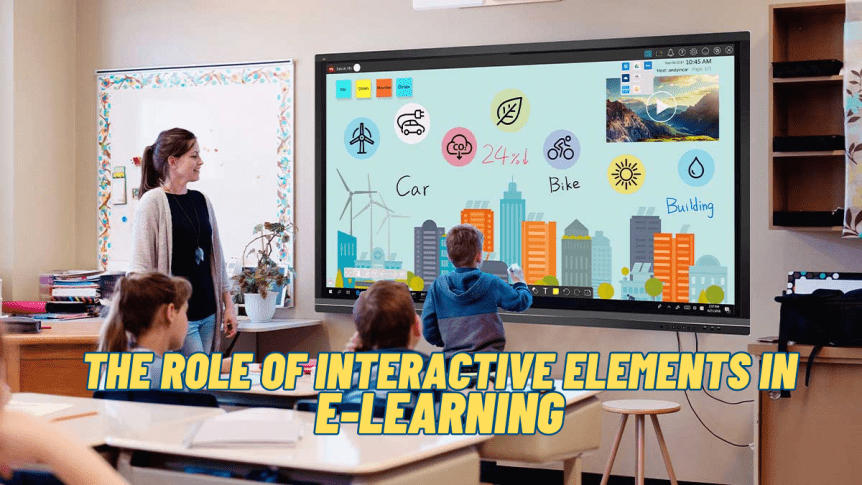The Role of Interactive Elements in E-learning
E-learning brings a range of benefits to corporate training programmes, including the ease with which training courses can be delivered and the convenience of completing training at a time that suits the learner. High levels of engagement are another benefit of e-learning. Interactive elements within e-learning courses are crucial to achieving these high engagement levels.
Therefore, the role of interactive elements in e-learning is worth exploring as interactivity in your training courses heavily influences success.
What is Interactivity in E-Learning?
Traditional employee training materials are often largely passive. Examples include training manuals or videos that employees either read or watch. With these types of training materials, employees passively receive the information.
E-learning technologies make it possible to include a level of interactivity in the training courses you develop, i.e., transitioning the learner from being a passive recipient of information to instead being an active participant in the training course. With interactive elements, the learner becomes more involved in the training by doing, thinking, and completing tasks.
The Benefits of Interactivity in Corporate Training
Including interactive elements in your corporate e-learning training courses brings seven main benefits.
- Facilitates learning – most people learn better by doing rather than simply listening, watching, or reading. As interactive elements create opportunities for learners to do things and get involved with the content, the training you create becomes more effective.
- Speeds up learning – as learning by doing is more effective, interactive elements in e-learning courses also speed up the learning process.
- Improves knowledge retention – it is one thing helping a learner to understand a topic or develop a skill during or immediately after a training course. Ensuring the learner retains this knowledge over the long term is a completely different challenge. Interactive elements in your training courses help to improve knowledge retention.
- Improved understanding – interactive elements can also bring clarity and a deeper level of understanding, particularly to complex topics. Again, this largely comes back to learning by doing, where employees can move from knowledge theory to practical application.
- Risk-free environment – practising a new skill or applying new knowledge in a real-world situation can present a range of risks, depending on the topic. However, an e-learning course creates a risk-free environment where learners can make mistakes and learn from them without any negative impact on the business, colleagues, customers, or themselves.
- Real-time feedback – in any training situation, it is important for learners to have an accurate understanding of their capabilities. For example, the learner might think they understand the topic better than they do. Conversely, a learner might think they are behind in their understanding when in fact they are progressing well. Interactive elements in e-learning courses can give learners immediate feedback so they know what areas they still need to work on.
- Improves the learner experience – creating good learning experiences is important for individual training courses and your overall training strategy. If learners enjoy the training courses they complete and find them worthwhile, they will be more likely to apply the new knowledge and they will be more open to future training courses. Interactive elements help improve the learner experience as learners get greater satisfaction from the courses they are engaged with.
Examples of Interactive Elements That Can Be Included in E-Learning Courses
- Training quizzes – quizzes are often viewed as a tool to measure progress and assess performance, but they can also be used as an interactive training tool.
- Assessments – assessment quizzes are another interactive element that should be included in almost all e-learning training courses.
- Gamified elements – gamification is a big topic in e-learning, not least because it can boost interactivity levels. Examples include giving learners badges or other rewards based on performance.
- Scenarios – scenarios, or simulations, put learners in realistic situations where they have to make decisions based on the new knowledge or skills they have learned. As a result, scenarios are one of the best learn-by-doing tools available when creating e-learning courses.
- Interactive videos – interactive videos can take your e-learning video content to another level as they move learners from being passive watchers of a video to active participants.
- Interactive graphics – you can take a similar approach with interactive graphics, moving them from passive to interactive elements. An example of an interactive graphic is one that includes a slider where you can see, for example, a before and after representation of an image.
- Click or tap and learn – getting the learner to click or tap on an element on the screen to reveal more information is a simple but effective way to include interactivity in your e-learning course.
- Rollover – for e-learning courses designed for computers, you can also include rollover elements, i.e., where information is displayed when the learner hovers their mouse pointer over an on-screen element.
- Navigation – navigational elements are functional, but they also bring a level of interactivity to e-learning courses.
- VR and AR – including virtual reality and augmented reality in your e-learning courses will take them to a whole new level of interactivity.
- Metaverse – the metaverse is another example of highly advanced interactive training.
Tips for Creating Interactive Elements in E-Learning Courses
- Make sure interactive elements are relevant and are not included for the sake of it.
- Make sure interactive elements contribute to the learning process.
- All elements in your e-learning courses, including interactive elements, should be high-quality and professionally produced.
- Use interactive elements to enhance personalisation and create better personalised learning experiences.
Finally, it is also important to assess the performance and impact of interactive elements. You should ask for feedback from learners to get their views. Assessing training results, from completion rates to quiz scores, can also help you assess the interactive elements you create.
